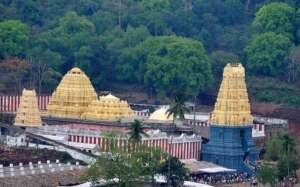History of Simhachalam
Sri Varaha Lakshmi Narasimha Swami temple, popularly known as the Simhachalam temple is one of the 32 Narasimha temples in the state of Andhra Pradesh, India which are important pilgrimage centers. The temple is picturesquely situated on western part of the Eastern Ghats locally known as the Kailasa Hill, 400 meters above the mean sea level and 300 meters from the city plain. Etymologically, the word Simhachalam means the hill of the lion. As per the inscriptions, the origin of this temple is dated back to 1098 AD of Kulottunga-I, the Chalukya Chola ruler. Narasimha Deva, the rler of Ganga Dynasty who was responsible for building the world heritage site of Konark temple, renovated this entire temple in the 13th century.
Picture Courtesy: Google Images
The temple is dedicated to Lord Vishnu, who is worshipped there as Varaha Narasimha. As per the temple’s legend, Lord Vishnu manifested in this form (Lion’s head and human body) after saving his devotee Prahlada from a murder attempt by the latter’s father Hiranyakashipu. In this temple there is a close connection between the Linga, Narasimha, and Varaha, who are considered to reside within the main temple. Except on the day of Akshaya Trutiya, the idol of Varaha Narasimha is covered completely with sandal paste throughout the year and is worshipped in the form of a Linga.
Simhachalam temple resembles a fortress from outside with three courtyards and five gateways. The architecture of the temple is unique, and it combines the traditions of Orissan and Dravidian styles which are known as the Nagara style. The major components of the main temple are the Asthanamandapa, Garbhagriha, Mukhamandapa, Tiruchuttumala and Stone Chariot. The temple faces west instead of east, signifying victory.
After Tirupathi Tirumalain Andhra Pradesh, Simhachalam is the second largest temple in terms of income earned.Kalyanotsava and Chandanotsava are the two major festivals celebrated in the temple, followed by Narasimha Jayanthi, Navaratrotsava and Kamadahana. Its only on the day of Chandanotsava, the devotees can see the original form of the deity


